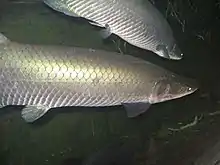Omagua or low jungle (selva baja or partially tierra caliente) is one of the eight[1] natural regions of Peru. It is located between 80 and 400m above sea level in the Peruvian Amazonia (Amazon rainforest). In this region, there are a lot of rivers that create meanders, swamps and lagoons.
The flora includes trees like cedro and palms (e.g. genus Phytelephas, tucumo (Astrocaryum aculeatum), shapaja (Attalea phalerata) and shebo (Attalea butyracea)). There are also plants like the Cattleya rex, a species of orchid.

The fauna includes animals like the capybara (which is the biggest rodent in the world), the giant armadillo, the jaguar, the giant otter, and the red brocket deer. There are also numerous species of birds, including the white-throated toucan, the hoatzin, the jabiru, and the red-and-green macaw. Animals that live in the water include the paiche, the Amazonian manatee and pipa toads.
Overview
Andean Continental Divide
| Westside | Eastside |
|---|---|
| Chala, dry coast | Lowland tropical rainforest or Selva baja |
| Maritime Yungas | Highland tropical rainforest or Selva alta |
| Maritime Yungas | Subtropical cloud forest or Fluvial Yungas |
| Quechua - Montane valleys | Quechua - Montane valleys |
| Tree line | Tree line - about 3,500 m |
| Suni, scrubs and agriculture | Suni, scrubs and agriculture |
Mountain top
- Mountain passes - 4,100 m
- Puna grassland
- Andean-alpine desert
- Snow line - about 5,000 m
- Janca - rocks, snow and ice
- Peak
See also
Literature
- ↑ Pulgar Vidal, Javier: Geografía del Perú; Las Ocho Regiones Naturales del Perú. Edit. Universo S.A., Lima 1979. First Edition (his dissertation of 1940): Las ocho regiones naturales del Perú, Boletín del Museo de historia natural „Javier Prado“, n° especial, Lima, 1941, 17, pp. 145-161.